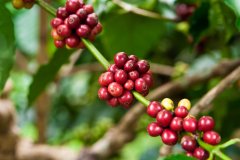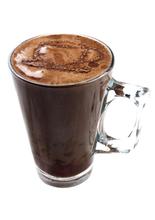Introduction to Hawaiian Kona Coffee with rich aroma and uniform acidity
The good quality of Kona coffee should be suitable for the right geographical location and climate. Coffee trees grow on the slopes of volcanoes, and their geographical location ensures the altitude needed for coffee growth; the dark volcanic ash soil provides the necessary minerals for coffee; the climate is very suitable, and the morning sun gently passes through the steamy air. In the afternoon, the mountains will become more humid and foggy, the white clouds surging in the air are the natural umbrellas for coffee trees, and the evening will become sunny and cool. Because of the suitable natural conditions, the average yield of Kona coffee is very high, reaching 2240 kg per hectare, while the yield of coffee in Latin America is only 600 kg to 900 kg per hectare.
Kona coffee has always been grown at home. At first, only men were allowed to work in the coffee garden, and later women joined in. This kind of family production of Hawaiians preferred to rely on the efforts of their families rather than hiring workers to work, so it was normal for Hawaiians to have eight or nine children at that time. Since then, new immigrants from the Philippines, the United States and Europe have come to Hawaii to engage in the coffee industry. Over time, Hawaii has formed a social atmosphere that centers on family culture and is easy to absorb foreign cultures. and make it a major feature of Hawaii. The harvest season of Kona coffee is from late August to January of the following year, farmers pick the ripe fruits in batches, and after treatment, they get the flavor and taste characteristics of coffee beans: strong aroma, uniform acidity and full granules. With cinnamon.
When it comes to Hawaii, the first thing that comes to mind is the swaying palm trees and the vast flat sandy beaches, as well as the endless blue sky and blue sea. The unique beauty of Hawaii also gives local coffee a unique attraction.
Hawaii is the only state in the United States that grows coffee. Coffee is grown on five major islands in the Hawaiian Islands, namely Oahu, Hawaii, Maui, Kauai and Moroca. Different islands also produce coffee with their own characteristics. Kona Coffee is produced in the west and south of the Kona region of Hawaii, spread over the slopes of Horala and Mauna Loa, which is 32 kilometers long and 3.2 kilometers wide.
It is said that coffee was first grown in Hawaii in 1813 when a Spaniard first grew coffee in the Manoa Valley on the island of Oahu, which is today the main campus of the University of Hawaii. In 1825, an English agronomist named John Wilkinson transplanted some coffee from Brazil to grow in the coffee garden of Chief Birch on the island of Oahu. Three years later, an American missionary named Samuel Riveland Rags brought the branches of the coffee tree from Birch Emirates Garden to Kona, a descendant of the Arabica coffee tree that first grew on the Ethiopian plateau. To this day, Kona Coffee still carries on its noble and ancient lineage

Important Notice :
前街咖啡 FrontStreet Coffee has moved to new addredd:
FrontStreet Coffee Address: 315,Donghua East Road,GuangZhou
Tel:020 38364473
- Prev

Elida Manor geisha cafe Coffee Net Cafe Order Coffee Flavor Perfect Coffee
Elida Estate Elida Estate
- Next

Delicious, rich, full-bodied Honduran specialty highland coffee
Honduras 'high-quality coffee uses water washing to treat coffee beans, usually after soaking, in the soaking time, defective fruit will surface, can be discarded first. The good fruit is then placed in a fruit peeler and peeled off by the rotating force of the machine. The peeled fruits are screened by machines to select excellent quality fruits. usually larger fruit
Related
- Does Rose Summer choose Blue, Green or Red? Detailed explanation of Rose Summer Coffee plots and Classification in Panamanian Jade Manor
- What is the difference between the origin, producing area, processing plant, cooperative and manor of coffee beans?
- How fine does the espresso powder fit? how to grind the espresso?
- Sca coffee roasting degree color card coffee roasting degree 8 roasting color values what do you mean?
- The practice of lattes: how to make lattes at home
- Introduction to Indonesian Fine Coffee beans-- Java Coffee producing area of Indonesian Arabica Coffee
- How much will the flavor of light and medium roasted rose summer be expressed? What baking level is rose summer suitable for?
- Introduction to the characteristics of washing, sun-drying or wet-planing coffee commonly used in Mantenin, Indonesia
- Price characteristics of Arabica Coffee Bean Starbucks introduction to Manning Coffee Bean Taste producing area Variety Manor
- What is the authentic Yega flavor? What are the flavor characteristics of the really excellent Yejasuffi coffee beans?

